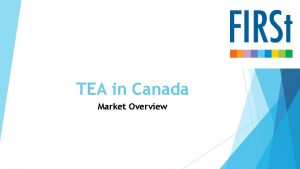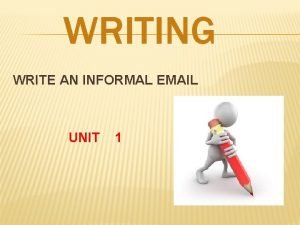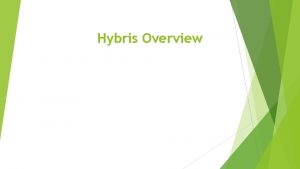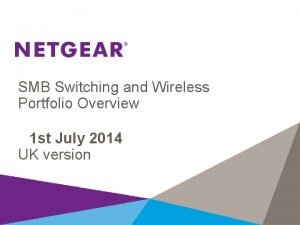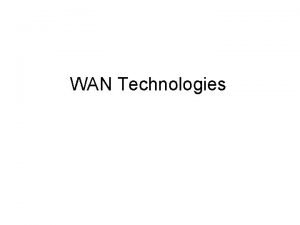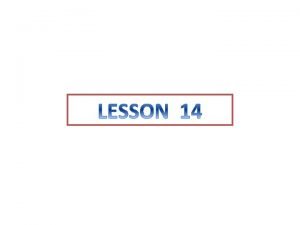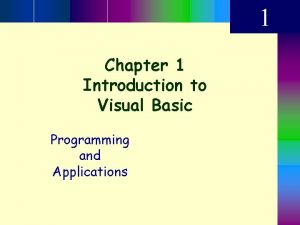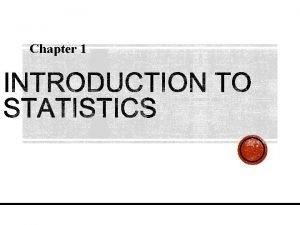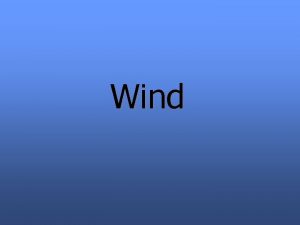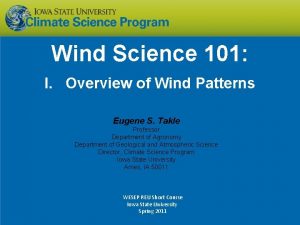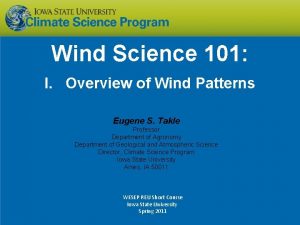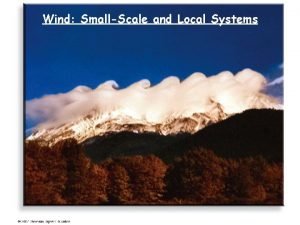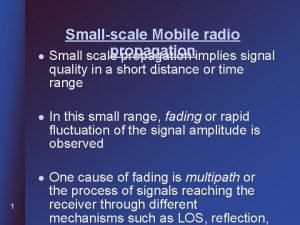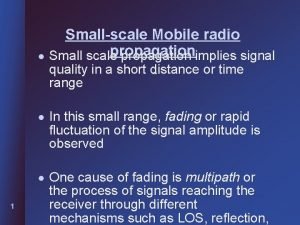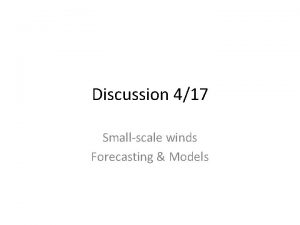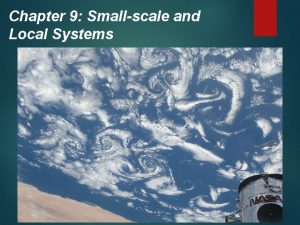Small Wind 101 An Overview of SmallScale Wind















- Slides: 15

Small Wind 101: An Overview of Small-Scale Wind Electric Systems Affordable, Clean Energy for Homes, Farms & Businesses

Why Wind? • Gain energy independence • Ease demand on the power grid • Reduce vulnerability to volatile utility prices • Reduce air pollution from fossil electricity sources

A Valuable, Widely-Available Resource Small Wind Energy Systems Value of Power = 6 -18¢ / k. Wh Installed cost of $2 -$3/Watt is 1/3 to 1/2 that of solar technologies Require less wind to operate than utility-scale wind energy applications

How Small Wind Turbines Work Wind Turbine (400 W-100 k. W) Guyed or Tilt-Up Tower (60 -120 ft) Safety Switch Cumulative Production Meter AC Load Center Power Processing Unit (Inverter)

Typical Applications Farms, Homes, Businesses Off-Grid Water Pumping with Wind Supplementing Grid Power • Supplies water for 120 head of cattle • 1 k. W, 9 -ft rotor, 30 -ft tower • Produces ~ 2, 000 k. Wh/yr • Offsets ~ 1. 5 tons CO 2/yr • Costs ~ $4, 000 installed • Connected to utility grid through house/farm wiring • 3 k. W, 15 -ft rotor, 23 -ft tower* • Produces ~ 5, 000 k. Wh/yr • Offsets ~ 3. 8 tons CO 2/yr • Costs ~ $10, 000 * due to zoning restrictions (not recommended)

Typical Applications Farms, Homes, Businesses Offsetting All Utility Power Selling Power Back to Utility • Excess power sold to utility • “Net metering” utility power • 10 k. W, 23 -ft rotor diameter, 100 -ft tower • 50 k. W, 49 -ft rotor, 90 -ft tower • Produces ~ 15, 000 k. Wh/yr • Produces ~120, 000 k. Wh/yr • Offsets ~ 14 tons CO 2/yr • Offsets ~ 91 tons CO 2/yr • Costs ~ $35, 000 • Costs ~ $150, 000

Frequently-Asked Questions • • • Will the noise bother my neighbors? What about visual impact? Do wind turbines kill birds? Will it interfere with TV/radio reception? Can wind supply power during an outage? • What happens during a tornado? Side furling: rotor turns to the side during extreme winds

Factors to Consider • Good wind resource: Class 2 or better • Home or business located on 1 acre or more of land • Average monthly electricity bills >$100 for 10 k. W system, >$50 for 5 k. W system • Zoning restrictions, economic incentives

Options: On or Off the Grid? Stand-Alone System • Batteries to store excess power • Charge controller • Inverter (DC to AC) • Back-up power source for complete energy independence Grid-Connected System • Inverter (DC to AC) • Annual wind speed >10 mph (4. 5 m/s) • Customer motivated by high utility prices, self sufficiency, or environmental concerns

Net-metering for Grid-Connected Systems • “Bank” excess energy with the local utility • Meter spins backward; customer receives full retail value for each k. Wh produced • Net excess generation (NEG) credited monthly or annually

Modern Small Wind Turbines High Tech, High Reliability, Low Maintenance • Small turbines range from 20 W to 100 k. W • Only 3 -4 moving parts means very low maintenance • 20 - to 40 -year design life • Proven technology – 150, 000 installed; over a billion operational hours • American companies are the market and technology leaders • Substantial cost-reduction potential

Historic Barriers to Small Wind Energy Systems • Economics: Low production volume & historical lack of public funding = high costs • Small wind upstaged by large-scale projects and other technologies • Zoning / Permits: 35 -ft height restriction in residential zones, noise, NIMBY attitudes • Onerous interconnection requirements • Low public awareness

New Technology is Lowering Costs U. S. DOE’s Advanced Small Wind Turbine Program + industry-funded R&D • Advanced airfoils • “Super-magnet” generators • Low cost manufacturing • Smart power electronics • Very tall towers • “Stealth” low noise & visual impact

Programs and Policies to Nurture the Rural Residential Market • Buy-down, rebate or grant programs • State production tax credits • Sales and property tax exemptions • Net metering, with annual “banking” period • Reasonable interconnection standards • Model zoning ordinances

Sources for Further Information on Small Wind • American Wind Energy Association Washington, DC 202 -383 -2500 www. awea. org/smallwind. html • U. S. DOE National Wind Technology Center Boulder, CO Clearinghouse: 800 -363 -3732 www. nrel. gov/wind/smalltur. html www. eren. doe. gov/erec/factsheets/wind. html www. eren. doe. gov/power/consumer/ • Home Power Magazine Ashland, OR 800 -707 -6585 www. homepower. com
 Wind von backbord weicht wind von steuerbord
Wind von backbord weicht wind von steuerbord What is bioinformatics an introduction and overview
What is bioinformatics an introduction and overview Tea consumption in canada
Tea consumption in canada Informal email writing
Informal email writing Moritz zimmermann sap
Moritz zimmermann sap Citibank overview
Citibank overview Sdn vs traditional networking
Sdn vs traditional networking Client devices portfolio overview
Client devices portfolio overview Texas public school finance overview
Texas public school finance overview Wan technologies
Wan technologies Followpos
Followpos Overview broadcom february
Overview broadcom february Introduction to visual basic
Introduction to visual basic British school system presentation
British school system presentation Data consists of
Data consists of 2 peter overview
2 peter overview


